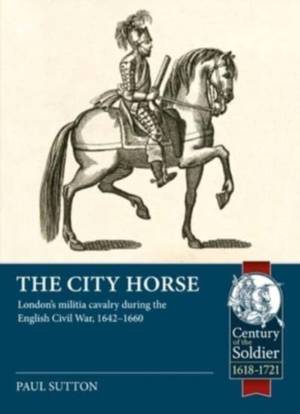
- Afhalen na 1 uur in een winkel met voorraad
- Gratis thuislevering in België vanaf € 30
- Ruim aanbod met 7 miljoen producten
- Afhalen na 1 uur in een winkel met voorraad
- Gratis thuislevering in België vanaf € 30
- Ruim aanbod met 7 miljoen producten
Zoeken
€ 48,95
+ 97 punten
Omschrijving
Throughout the English Civil War numerous militia and auxiliary cavalry formations were raised at the behest of Parliament in and around the City of London, which have been collectively called the City Horse. Using an extensive array of primary sources this book describes in detail the raising, equipping, maintenance and deployment of these units and analyses how effective they were in the Parliamentary war effort. The book follows the various units from their baptism of fire at Winchester in 1642, the main campaigns of 1643 & 1644, through to their peripheral role in the Parliamentary victory in 1645/46. It then describes the important role they played during the heady summer of 1647 as the New Model Army marched on the nation's capital to seek redress, as well as the part they played in the political turmoil in London during the Second Civil War in 1648. It further describes their reorganization under the Commonwealth, their participation at the Battle of Worcester in 1651, how some of the senior officers sought to prolong the English Republic and finally, how the City Horse welcomed the entry of Charles II into London in 1660. Uniquely amongst the units raised during the wars, the City Horse served throughout the conflict.
The book demonstrates clearly how political imperatives created and molded this body of troops and how it was used as a pawn in the greater game of chess that was the English Revolution. It is a story of zealous political and religious individuals, of greed, avarice, treachery and naked ambition. It is a story of individuals, brought together by the political maelstrom of their times and how they endeavored to do what they considered to be right. The book recounts bravery and also not a small amount of cowardice.
Finally, the book is a testimony to those Londoner's who served, and to those who died, in the City Horse, a military formation until now that has been sadly neglected by military historians.
The book demonstrates clearly how political imperatives created and molded this body of troops and how it was used as a pawn in the greater game of chess that was the English Revolution. It is a story of zealous political and religious individuals, of greed, avarice, treachery and naked ambition. It is a story of individuals, brought together by the political maelstrom of their times and how they endeavored to do what they considered to be right. The book recounts bravery and also not a small amount of cowardice.
Finally, the book is a testimony to those Londoner's who served, and to those who died, in the City Horse, a military formation until now that has been sadly neglected by military historians.
Specificaties
Betrokkenen
- Auteur(s):
- Uitgeverij:
Inhoud
- Aantal bladzijden:
- 344
- Taal:
- Engels
- Reeks:
Eigenschappen
- Productcode (EAN):
- 9781804511992
- Verschijningsdatum:
- 24/05/2023
- Uitvoering:
- Paperback
- Formaat:
- Trade paperback (VS)
- Afmetingen:
- 180 mm x 249 mm
- Gewicht:
- 914 g

Alleen bij Standaard Boekhandel
+ 97 punten op je klantenkaart van Standaard Boekhandel
Beoordelingen
We publiceren alleen reviews die voldoen aan de voorwaarden voor reviews. Bekijk onze voorwaarden voor reviews.








